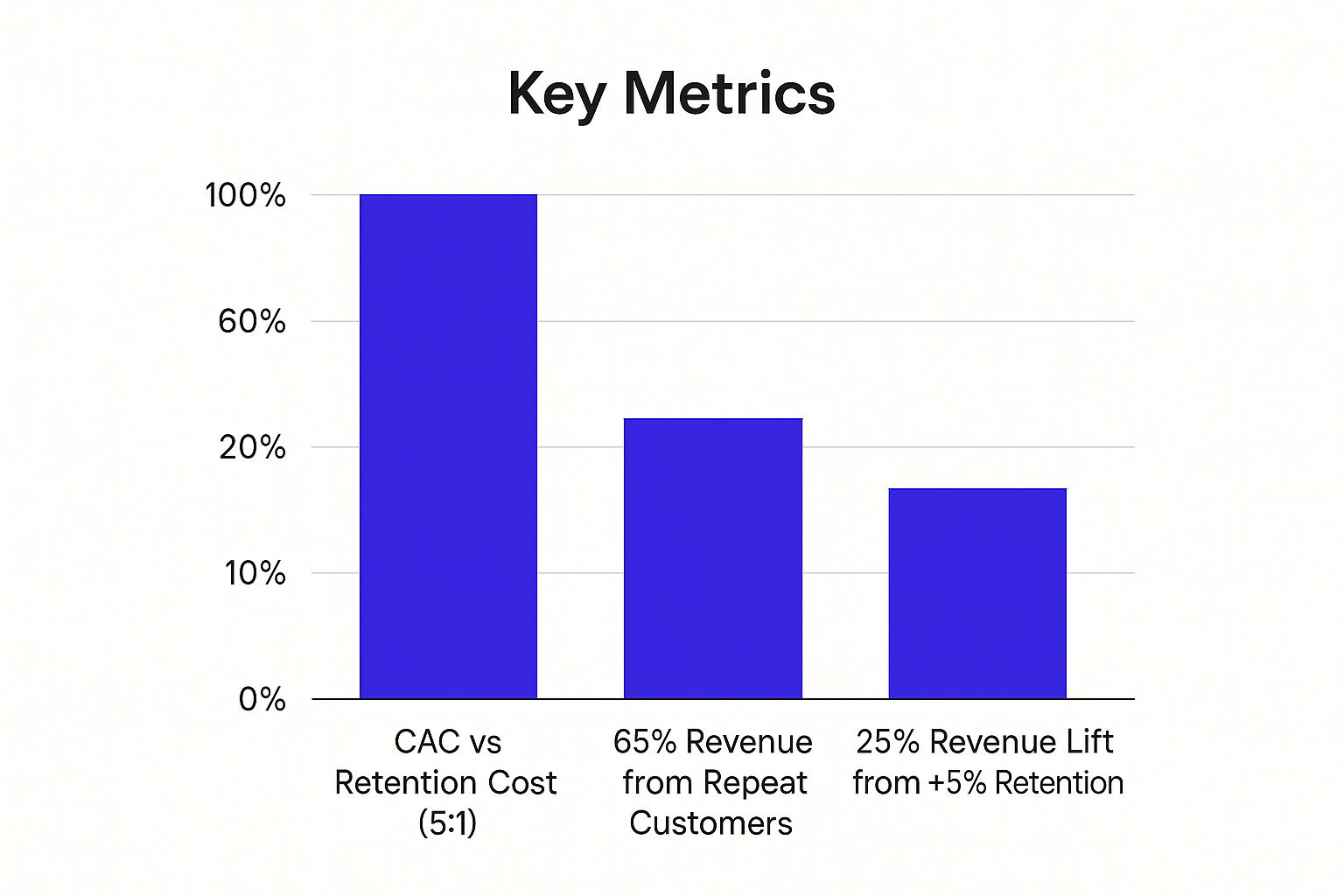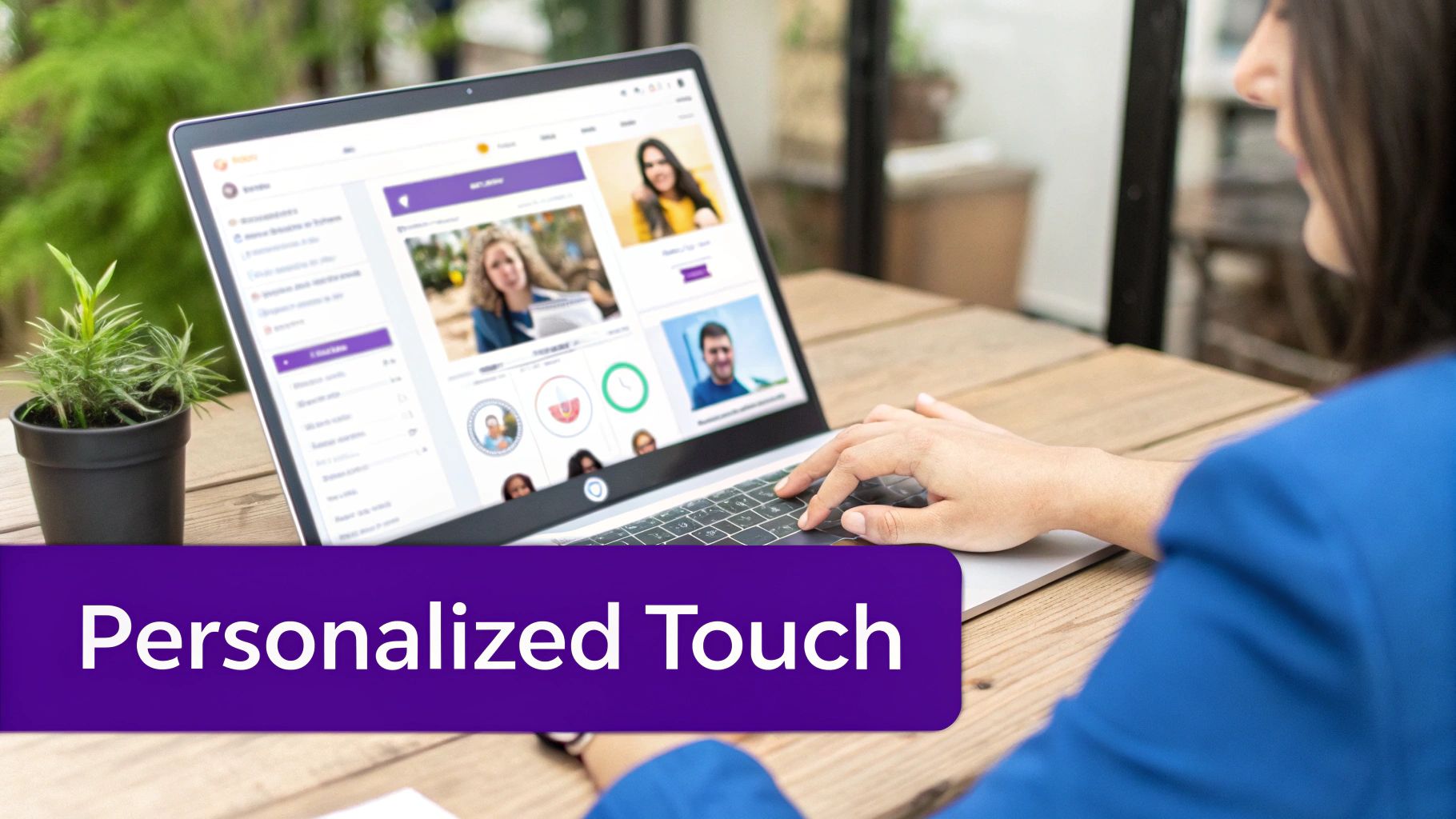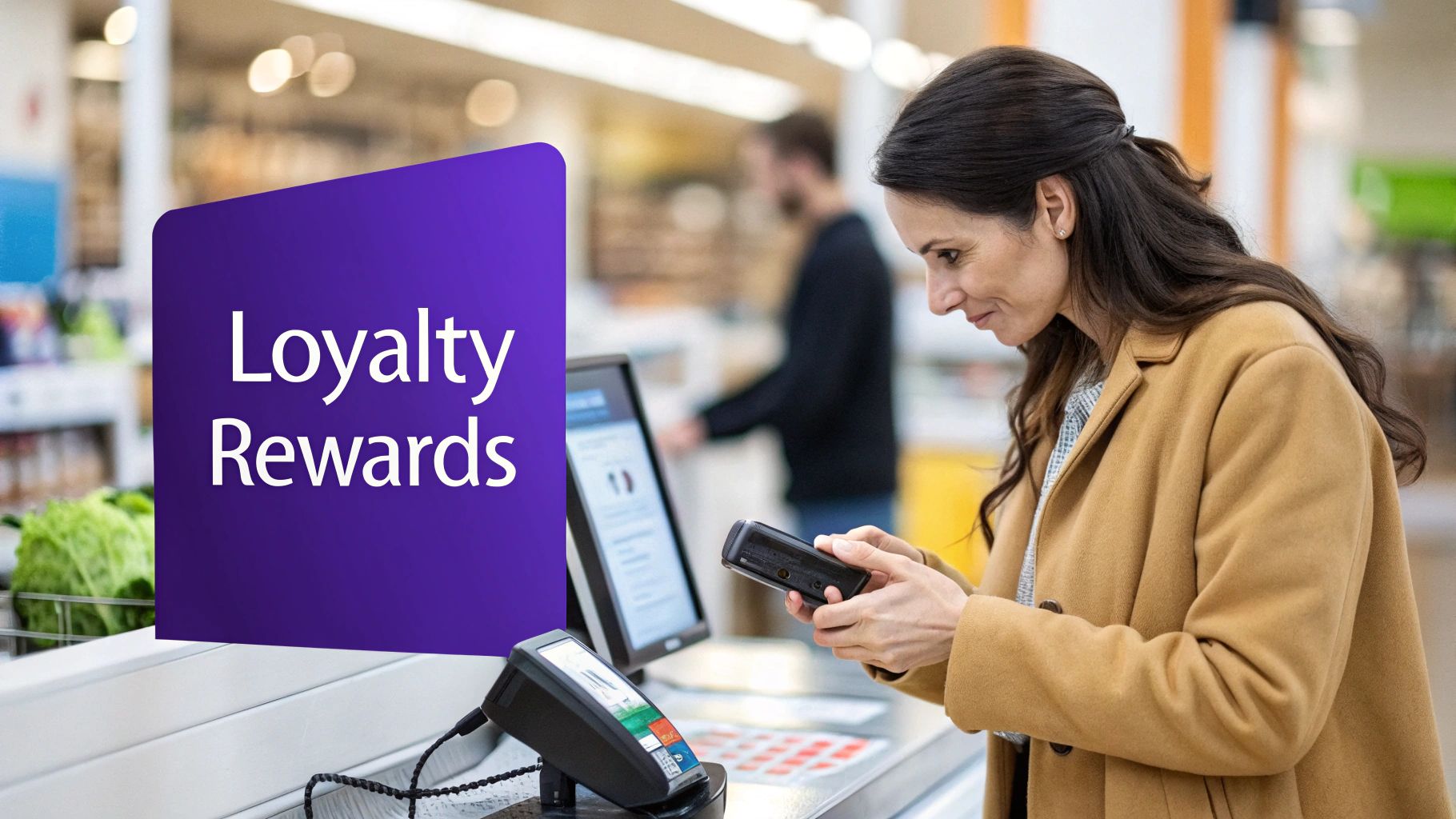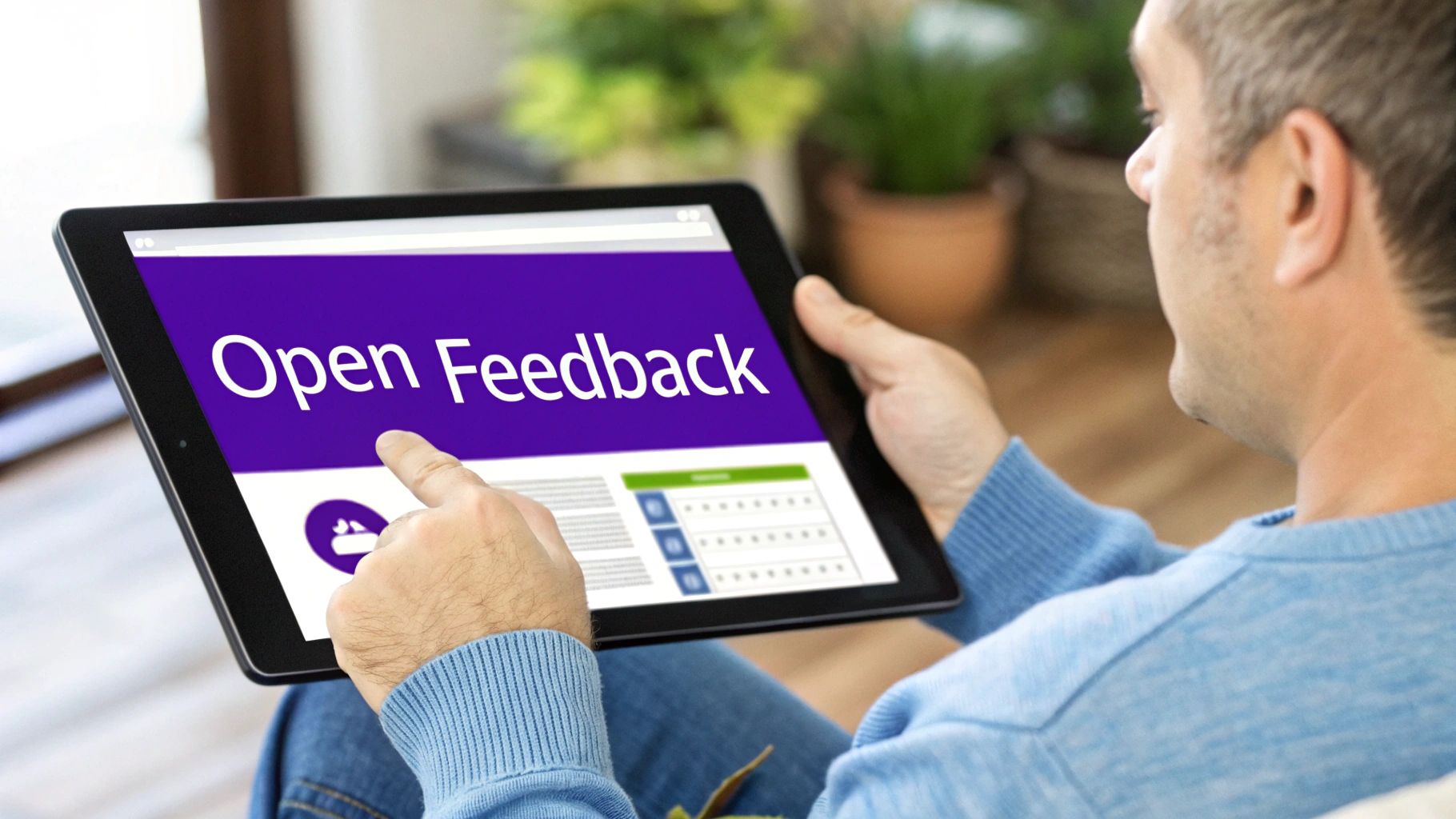How to Improve Customer Retention for Lasting Growth
Discover how to improve customer retention with proven strategies. Learn to build loyalty, gather feedback, and create experiences that drive repeat business.
Posted by
Let's be honest. When you're trying to grow your business, it's easy to get obsessed with chasing new leads. We've all been there, pouring time and money into customer acquisition. But what if the biggest growth opportunity isn't out there, but right here?
It's your existing customers. The ones who already know you, trust you, and have chosen to spend their money with you. Focusing on keeping them happy isn't just a defensive move—it's one of the smartest, most cost-effective ways to build a business that lasts.
Why Customer Retention Is Your Biggest Growth Lever
Shifting your mindset from hunting for new business to nurturing what you've already built can feel like a big change. But the truth is, happy customers are the foundation of a healthy business ecosystem.
Think about it. These are the people who are less likely to flinch at a price adjustment, more willing to forgive a minor slip-up, and almost always the first in line to try out your new products. Their value isn't a one-time transaction; it compounds over time, creating a reliable and growing stream of revenue you can count on.
The Financial Power of Loyalty
The numbers don't lie, and when it comes to retention, they're staggering.
Here’s a hard truth: acquiring a new customer can cost five times more than keeping an existing one. That fact alone should make you pause. Every dollar you invest in making a current customer feel seen and valued is a dollar you don't have to burn on expensive ad campaigns just to fill a leaky bucket.
Even small gains here have a massive impact. A mere 5% bump in customer retention can boost your profits anywhere from 25% to 95%. It's not a linear relationship; it’s exponential. This shows that tiny, consistent efforts in retention can completely reshape your bottom line.
This chart really drives the point home, showing the massive gap between acquisition costs and the upside of retention.

The data is crystal clear. Repeat customers are the engine of profitability. They generate the bulk of revenue and deliver a huge lift from even a small increase in their loyalty.
Beyond Revenue: A Flywheel of Growth
But the real magic of retention goes way beyond the balance sheet. Your happiest, most loyal customers will eventually become your best marketing channel—and they work for free.
They're the ones leaving glowing testimonials, spreading the word to their friends, and sending high-quality referrals your way.
When you focus on the customer experience, you create advocates who build your brand for you. Their trust becomes your most valuable asset, creating a moat around your business that competitors can't easily cross.
To summarize these ideas, a modern retention strategy really comes down to a few core pillars. These are the foundational elements you need to get right.
Core Pillars of a Modern Retention Strategy
| Pillar | Objective | Key Actions |
|---|---|---|
| Connection | Build an authentic, ongoing relationship with customers. | Launch loyalty programs, celebrate customer milestones, create a community forum. |
| Feedback | Show customers you're listening and value their input. | Implement feedback surveys, respond to reviews (good and bad), act on suggestions. |
| Personalization | Deliver experiences that feel unique to each customer. | Use purchase history for recommendations, tailor email offers, customize user dashboards. |
Ultimately, building a business that thrives for the long haul requires a deep understanding of these principles. For a closer look at what works, check out these proven strategies to reduce customer churn. By mastering connection, feedback, and personalization, you can stop plugging leaks and start building a powerful, self-sustaining growth engine.
Design a Loyalty Program That Builds Community
Let's be honest. When you hear "loyalty program," you probably picture a crumpled punch card or some points system that feels like a painfully slow crawl toward a 10% discount.
While those old-school transactional models aren't totally useless, they rarely build the kind of deep, emotional connection that turns a casual customer into a genuine brand advocate. The real goal isn't just to reward purchases; it's to create a genuine sense of belonging. It's about community.
A killer loyalty program makes customers feel like insiders—like they're part of an exclusive club that gets them. This is the bedrock of improving customer retention because it fundamentally shifts the dynamic from transactional to relational. When people feel valued for more than just their last purchase, they stick around. It's no secret that a company's future profits often flow from a small, fiercely loyal group of existing customers.
Go Beyond Points and Discounts
The most powerful loyalty programs offer rewards that you can't just slap a dollar value on. Sure, discounts have their place, but it's the non-monetary perks that forge a stronger, more memorable bond. You have to ask yourself: what can we offer that our competitors can't easily copy?
Think about these kinds of community-building rewards:
- Exclusive Access: Give your members first crack at new product launches. Offer them a "behind-the-scenes" peek at your creative process or unlock a members-only section of your site with special content.
- Priority Service: A dedicated customer support line or faster shipping for your most loyal members is a simple gesture that screams, "We value your time and your business."
- Community Recognition: Feature a loyal customer on your social media. Create a "member of the month" spotlight in your newsletter. Public recognition is an incredibly powerful way to make someone feel seen and appreciated.
Imagine a boutique coffee roaster. Instead of just another free latte, what if they invited their loyalty members to an exclusive tasting event with the head roaster? That's an experience. It creates a story and a memory—things that are far stickier than a simple discount.
True loyalty isn't bought with discounts; it's earned by making customers feel like they are part of something special. When you create a community, retention becomes a natural byproduct of that shared identity.
This whole approach taps into a basic human need: the desire to belong. By building a program that fulfills that need, you create an emotional moat around your brand that price alone can't breach.
Choose the Right Loyalty Model
There's no one-size-fits-all loyalty program. The right model depends entirely on your brand, your products, and—most importantly—your customers. Trying to shoehorn a generic program into your business is a recipe for something totally forgettable.
Here are a few models to get you thinking, from the simplest to the more involved:
1. The Surprise and Delight Model This is less of a formal "program" and more of a consistent practice of rewarding customers when they least expect it. Think of a handwritten thank-you note tucked into a package, an unannounced free gift, or a surprise upgrade. It feels personal and genuine because it’s not tied to any specific action. It just happens. The clothing brand West Path pops a free sticker in every package—a tiny, low-cost gesture that creates a surprisingly memorable unboxing moment.
2. The Tiered VIP Club This model is brilliant for building aspiration. Customers start at a base level and unlock better rewards and a higher status as they engage more. The trick is making the benefits at each tier genuinely desirable.
- Tier 1 (Bronze): Early access to sales.
- Tier 2 (Silver): Free shipping on all orders and a birthday gift.
- Tier 3 (Gold): An invitation to an annual members-only event and a dedicated support contact.
Sephora's Beauty Insider program is a masterclass in this approach. It expertly motivates customers to climb the ladder from Insider to VIB to the coveted Rouge status with increasingly exclusive perks.
3. The Experiential Program This is where you can truly set your brand apart. Experiential rewards are all about providing unique, money-can't-buy experiences. This works exceptionally well for lifestyle brands or companies with a strong mission. An outdoor gear company might offer a guided hike. A cookware brand could host a virtual cooking class with a well-known chef. These experiences forge powerful emotional connections and create shareable moments that fuel organic marketing.
Leverage Social Proof to Build Unshakeable Trust
Let's be honest: your happiest customers are your most powerful marketing asset. But their stories won't tell themselves. If you're serious about keeping customers around for the long haul, you need a smart way to capture their voices and turn those individual wins into a powerful wave of trust.

Think about it. When potential buyers are on the fence, they don't go looking for more of your marketing copy. They look for proof from people just like them. This is where testimonials, reviews, and user-generated content (UGC) become absolute gold. They offer an authentic, unbiased view that cuts through skepticism and builds credibility in a way no advertising slogan ever could.
This isn't just a gut feeling; the data is crystal clear. Nielsen found that a staggering 92% of consumers trust recommendations from friends and family above all other kinds of advertising. When people see that others have already found success with your product, it builds a foundation of trust that traditional marketing can only dream of.
Make It Easy for Customers to Share Their Story
So, what's the biggest roadblock to collecting testimonials? It’s not that your customers are unwilling to share their success—it’s that we usually make the process a clunky, inconvenient chore. Asking someone to write a long review and email it over is a pretty big ask for a busy person.
You have to make it frictionless.
Instead, think about how you can weave the request right into their journey. A well-timed automated email a few weeks after a purchase can work wonders, especially if you frame it around their success, not your need for marketing collateral. Swap out "Leave us a review" for something like, "We'd love to hear how you're using [Product Name] to achieve [Goal]."
This is exactly the problem platforms like EndorseFlow were built to solve. It automates the collection process, allowing customers to submit video testimonials with just a few clicks on their phone. This completely removes the friction, making it effortless for them to share their excitement when they're most enthusiastic about your brand.
The key is to ask for feedback at the peak of your customer's excitement. Whether that's right after they've achieved a milestone with your product or just received exceptional service, timing is everything.
Deploy Social Proof Where It Matters Most
Collecting testimonials is only half the job. You have to put them to work strategically to actually make a dent in your retention and acquisition numbers. Your social proof can't just live on a forgotten "Testimonials" page; it needs to be woven into the very fabric of your customer's experience.
Here are a few high-impact places I've seen work incredibly well:
- On Product Pages: Place a relevant review right next to the "Add to Cart" button. A quote from a customer who was hesitant but ultimately thrilled can be the final nudge a new buyer needs.
- In Email Campaigns: Drop a short, punchy testimonial into your onboarding sequence or newsletters. It’s a simple way to reinforce your product's value and remind existing customers why they chose you.
- Within Ad Campaigns: Use compelling video testimonials in your social media ads. Hearing a real person's genuine enthusiasm is far more persuasive than even the cleverest ad copy.
By placing these authentic stories in the right spots, you create a constant stream of validation that reassures both new and existing customers they made the right choice. For a complete walkthrough on this, check out our guide on how to get customer testimonials that actually convert. This approach doesn't just attract new business—it reinforces your value to your current customers, making them far less likely to churn.
Listen Up: Build a Proactive Customer Feedback System
Stop waiting for things to go wrong. Seriously. The brands that win don't just solve problems—they get ahead of them by listening to what their customers are actually saying. Building a proactive customer feedback system means you stop reacting to complaints and start actively shaping a better experience.

This isn’t about blasting out a generic survey once a year and calling it a day. It’s about creating an ongoing conversation that gathers timely, actionable insights. When you ask for feedback at just the right moments, you’re sending a clear signal: you value their opinion. They stop feeling like just a number and start feeling like a partner in your brand's journey.
This little shift turns data collection from a one-way street into a powerful dialogue. And when customers see their suggestions lead to real changes? Their loyalty deepens. They become far more likely to stick with you for the long haul.
Go Way Beyond the Annual Survey
To get a real pulse on how your customers are feeling, you need to collect feedback at multiple points along their journey. A single, annual survey only gives you a blurry snapshot in time. Instead, you need to mix it up to capture insights when they're still fresh and relevant.
I’ve seen these tactics work wonders:
- Post-Purchase Check-ins: A simple, automated email sent a week or two after a product lands on their doorstep can be incredibly powerful. Don't be generic. Ask specific questions like, "What was one thing you loved about your unboxing experience?" or "Is [Product Name] meeting your expectations so far?"
- Net Promoter Score (NPS) Surveys: The NPS is a classic for a reason. Asking "How likely are you to recommend us to a friend?" gives you a clean metric you can track over time. But the magic is in the follow-up. Always add an open-ended question like, "What’s the main reason for your score?" That's where the gold is.
- Informal Customer Chats: For your most engaged customers, a quick 15-minute chat can tell you more than a hundred survey forms. Offer a small incentive like a gift card and just ask them to walk you through their experience with your brand. It’s that simple.
By mixing your methods, you get both the hard data (NPS scores) and the human stories (interview anecdotes), giving you a much richer, more complete picture of your customer experience.
Always Close the Feedback Loop
Collecting feedback is just step one. The real magic happens when you close the loop—getting back to customers to show them you listened and, more importantly, acted. Honestly, nothing builds trust faster than proving their voice actually matters.
This taps into something called the service recovery paradox. It’s a wild concept: customers who have a problem that you resolve effectively can become even more loyal than those who never had a problem in the first place. Closing the feedback loop is your chance to proactively trigger this effect.
Picture this: a customer suggests a new feature for your software. Months later, you finally build it. Instead of just announcing it on your blog, you send a personal email to that customer. "Hi Jane, a few months back you mentioned you wished our tool could do X. Well, we listened. I'm thrilled to let you know we just launched it. Thanks again for the fantastic idea!"
That simple act turns a passive user into a passionate advocate. You’ve validated their input and made them feel like a co-creator. Getting this process right requires a system, of course, but it’s a direct investment in keeping your customers around. To really nail this, you need to master customer feedback analysis to drive growth, which will help you turn all that raw data into a powerful retention engine.
Deliver Hyper-Personalized Customer Experiences

Let's be real. In a world of generic marketing blasts and one-size-fits-all offers, true personalization is what makes a brand stick. It’s the difference between a customer feeling like a number on a spreadsheet and feeling like you actually get them.
Going beyond just dropping a {{first_name}} into an email is where the magic happens. Thoughtful, data-driven interactions show you’re paying attention, turning a simple transaction into a relationship built on trust. This isn't just a nice-to-have; it's a must-do.
For industries like travel, hospitality, and restaurants, where the average retention rate hovers at just 55%, personalized service is a survival tool. It’s what separates the thriving from the forgotten.
Use Data to Anticipate Needs
The bedrock of any great personalization strategy is data. You're probably sitting on a goldmine of information right now that can help you create these unforgettable experiences. The goal is to connect the dots between what a customer has done and what they might need next.
This means digging deeper than surface-level details. Look at their purchase history, the pages they browse on your site, and any preferences they've openly shared. Using a tool like Salesforce's robust CRM platform is a game-changer here, letting you pull all that customer data into one place to craft interactions that feel genuinely personal.
Once you understand these patterns, you can stop reacting and start engaging proactively.
Craft Truly Tailored Interactions
With a clearer picture of your customer, you can start building experiences that feel like they were made just for them. This is where you get to be creative and prove you’ve been listening.
Here are a few ways to bring this to life:
- Customized Product Recommendations: If a customer keeps buying hiking gear, don't send them an email about beach towels. Show them new trail-running shoes or waterproof jackets. It proves you know what they're into.
- Surprise-and-Delight Offers: Did a loyal customer just have a birthday? Send them a special discount on something they’ve viewed a few times. It’s a small, unexpected gesture that creates a massive emotional impact.
- Proactive Service Alerts: If you sell a product that needs refills or maintenance, send a heads-up before it becomes a problem. A pet food company, for instance, could email a customer when they’re likely running low based on their last order.
The real goal of personalization is to make your customer feel seen and understood. When you anticipate their needs and talk to them in a way that reflects their unique journey, you’re no longer just a vendor—you’re a trusted advisor.
This level of detail is your best defense against churn. Why would a customer look elsewhere when they feel like you're personally invested in their success? For more practical strategies on keeping customers around, check out our guide on mastering the art of reducing churn rate.
Ultimately, this isn’t about just sending better emails. It’s about transforming generic broadcasts into meaningful conversations. It's this commitment to understanding the individual that builds the kind of loyalty that fuels real, sustainable growth.
Even with the best game plan, actually kicking off a customer retention program brings up a ton of questions. It's one thing to have the strategies, but it's another to know where to start, what to expect, and how to avoid spinning your wheels.
Let's cut through the noise and tackle some of the most common questions I hear from business owners. The goal here is to give you direct, practical answers so you can get started on the right foot.
What Is the First Step I Should Take?
Before you do anything else, you have to stop guessing and start measuring. You can't improve what you don't understand. Your single most important first move is to figure out your customer churn rate—that’s the percentage of customers who walk away and don't come back over a set period. This one number is your baseline. It's your starting line.
Once you know your churn rate, the next logical step is to find out why they're leaving. You don't need a fancy, expensive system for this. A simple, automated email survey sent to customers who've just canceled or haven't bought anything in a while can give you incredible clarity. Just ask them directly what went wrong or what you could have done better.
The feedback you get in these early days is pure gold. It shines a spotlight on your biggest opportunities, whether that’s a clunky product, slow customer service, or just a failure to keep them engaged with your brand.
This two-step punch—calculating churn and then gathering feedback—gives you a rock-solid foundation. From here on out, every strategy you implement will be aimed at solving a real, identified problem, not just one you think you have.
How Can a Small Business Implement These Strategies?
It's a huge myth that you need a massive budget to boost customer retention. For small businesses, it's not about expensive software; it's about being authentic, creative, and personal. The key is to lean into high-impact, low-cost strategies.
Forget about a complex, points-based loyalty program for now. Start with a simple "surprise and delight" approach. It’s all about creating small, unexpected moments that make your customers feel seen.
- Handwritten Thank-You Notes: Tucking a personal note into a package for a repeat buyer costs almost nothing but creates an experience they'll remember and talk about.
- Small, Unexpected Gifts: A free sticker, a sample of a new product, or a small discount code sent "just because" builds a ton of goodwill.
For gathering feedback, you can skip the pricey survey tools. Free platforms like Google Forms work perfectly for creating and sending customer surveys. And when it comes to personalization, it can be as simple as segmenting your email list by past purchases and sending more relevant tips or offers. The goal is to be thoughtful and consistent—that’s what proves you care, and it won't break the bank.
How Long Does It Take to See Results?
Patience. That’s the keyword when it comes to customer retention. While you can see some encouraging signs pretty quickly, the real, measurable impact on your bottom line will take a bit of time to show up.
You should start seeing some early signs of success within the first one to three months. These are usually engagement metrics, not financial ones.
- Higher open and click-through rates on your emails.
- More positive shoutouts and interactions on social media.
- A jump in response rates to your feedback surveys.
These are fantastic signals that what you're doing is working. But a significant, measurable lift in your overall retention rate and customer lifetime value? That usually takes longer, often around six to twelve months.
Retention is a long game. Your initial efforts build the foundation, and the financial payoffs—like lower churn and higher profits—start to compound over time as those customer relationships get stronger. Keep an eye on both the short-term engagement wins and the long-term financial outcomes to see the full picture.
Ready to turn your happiest customers into your most powerful marketing assets? With EndorseFlow, you can effortlessly collect authentic video testimonials and streamline your social media presence. Stop chasing reviews and start building unshakable trust. Try EndorseFlow risk-free for 14 days!